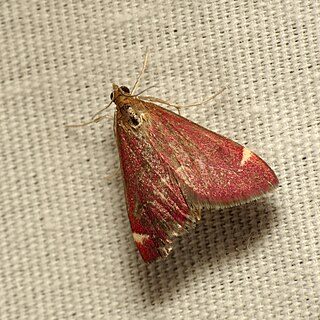Cacozelia basiochrealis, the yellow-based cacozelia, is a species of snout moth in the genus Cacozelia. It was described by Augustus Radcliffe Grote in 1878. It is found in the southern part of the United States.
Evergestis simulatilis is a moth in the family Crambidae. It was described by Augustus Radcliffe Grote in 1880. It is found in North America, where it has been recorded from Alberta, Arizona, British Columbia, California, Colorado, Montana, Nevada and New Mexico.
Loxostege allectalis is a moth in the family Crambidae. It was described by Augustus Radcliffe Grote in 1877. It is found in the United States, where it has been recorded from southern California to Texas. To the south, the range extends into Mexico and Central America.
Loxostege anartalis is a moth in the family Crambidae. It was described by Augustus Radcliffe Grote in 1878. It is found in North America, where it has been recorded from coast to coast in Canada. In the west, the range extends south to California.
Pyrausta atropurpuralis is a moth in the family Crambidae. It was described by Augustus Radcliffe Grote in 1877. It is found in North America, where it has been recorded from Texas, New Mexico and Colorado.

Pyrausta bicoloralis, the bicolored pyrausta moth, is a moth in the family Crambidae. It was described by Achille Guenée in 1854. It is found in North America, where it has been recorded from Nova Scotia south to Florida, west to Michigan and Texas. In the south, the range extends to South America.
Pyrausta coccinea is a moth in the Crambidae family. It was described by William Warren in 1892. It is found in North America, where it has been recorded from California.
Pyrausta dapalis is a moth in the Crambidae family. It was described by Augustus Radcliffe Grote in 1881. It is found in North America, where it has been recorded from California and Oregon.
Pyrausta flavofascialis is a moth in the Crambidae family. It was described by Augustus Radcliffe Grote in 1882. It is found in North America, where it has been recorded from western Texas to Arizona. It is also found in Mexico.
Pyrausta generosa is a moth in the Crambidae family. It was described by Augustus Radcliffe Grote and Coleman Townsend Robinson in 1867. It is found in North America, where it has been recorded from Ontario to Alberta and to Florida and Missouri. The habitat consists of undisturbed areas in aspen parkland and mixed woods.

Pyrausta grotei is a moth in the Crambidae family. It was described by Eugene G. Munroe in 1976. It is found in North America, where it has been recorded from Washington, Oregon, Montana, California, Utah, Colorado, Wyoming, Nevada, Arizona and Texas.
Pyrausta insignitalis, the dark-banded pyrausta moth, is a moth in the Crambidae family. It was described by Achille Guenée in 1854. It is found in the United States, where it has been recorded from Florida and South Carolina. It is also found on the West Indies, as well as in Central and South America.
Pyrausta lethalis, the lethal pyrausta moth, is a moth in the Crambidae family. It was described by Augustus Radcliffe Grote in 1881. It is found in North America, where it has been recorded from California to southern Nevada, southern Arizona and Texas.
Pyrausta nicalis is a moth in the family Crambidae. It was described by Augustus Radcliffe Grote in 1878. It is found in North America, where it has been recorded from Quebec west to British Columbia, south to Colorado, Utah, Nevada and California.
Pyrausta niveicilialis, the white-fringed pyrausta moth, is a moth in the family Crambidae. It was described by Augustus Radcliffe Grote in 1875. It is found in North America, where it has been recorded from southern Canada to Florida and west to Colorado.
Pyrausta semirubralis is a moth in the Crambidae family. It was described by Alpheus Spring Packard in 1873. It is found in North America, where it has been recorded from southern British Columbia to California, Nevada, Colorado and Arizona. The habitat consists of coastal areas, reaching inland up to altitudes of about 9000 ft.
Pyrausta socialis, the sociable pyrausta moth, is a moth in the family Crambidae. It was described by Augustus Radcliffe Grote in 1877. It is found in North America, where it has been recorded from Ontario west to British Columbia, south to Montana and Colorado.
Pyrausta subsequalis is a moth in the family Crambidae. It was described by Achille Guenée in 1854. It is found in North America, where it has been recorded from southern Alberta and southern British Columbia south to Arizona and New Mexico. The habitat consists of dry prairie areas.
Pyrausta volupialis, the volupial pyrausta moth, is a moth in the Crambidae family. It was described by Augustus Radcliffe Grote in 1877. It is found in North America, where it has been recorded from Oklahoma, Utah, Texas, Colorado, New Mexico, Arizona and California to Chiapas, Mexico.

Diacme adipaloides, the darker diacme moth, is a moth in the family Crambidae. It was described by Augustus Radcliffe Grote and Coleman Townsend Robinson in 1867. It is found in North America, where it has been recorded from Alabama, Arkansas, Florida, Indiana, Maine, Maryland, Massachusetts, Michigan, Minnesota, New Brunswick, New Hampshire, New Jersey, New York, North Carolina, Nova Scotia, Ohio, Oklahoma, Ontario, Quebec, South Carolina, Tennessee, Texas, Virginia, West Virginia and Wisconsin.






